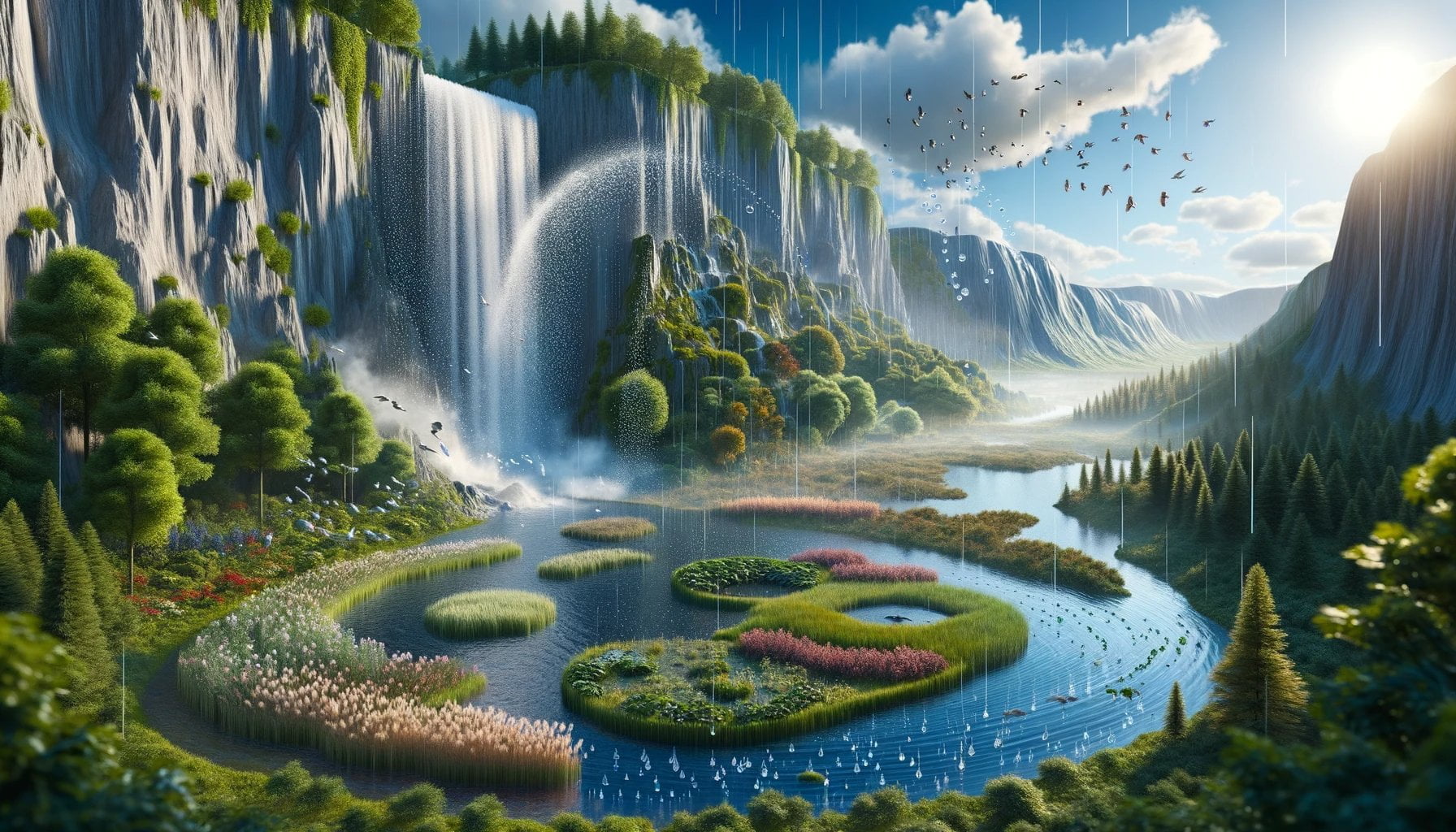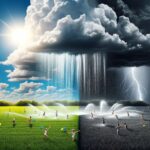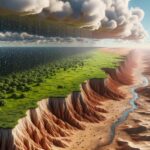When it comes to understanding the complex workings of the Earth’s water cycle, the study of precipitation plays a vital role. From rain and snow to hail and sleet, the different forms of precipitation contribute to the intricate web of water that sustains life on our planet. In this article, we will delve into the fascinating world of the precipitation water cycle, exploring its definition, examples, and the intricate processes that drive this essential natural phenomenon. By unraveling the dynamics of the precipitation water cycle, we gain a deeper appreciation for its impact on ecosystems, agriculture, and our urban infrastructure. Join us on this insightful journey into the realm of hydrology and water resource management as we unveil the hidden intricacies of the precipitation water cycle.
Precipitation Water Cycle
The precipitation water cycle is a captivating natural phenomenon that plays a vital role in shaping our planet’s ecosystems and sustaining life as we know it. Let’s dive into the intricacies of this dynamic process and unravel its fascinating dynamics.
What is the Precipitation Water Cycle?
The precipitation water cycle refers to the continuous movement and transformation of water between the Earth’s surface, atmosphere, and back again. It is a delicate balance that drives the distribution of water resources and influences our climate patterns.
The Dance of Condensation and Precipitation
At the heart of the precipitation water cycle lies the dance between condensation and precipitation. It begins with the sun’s energy heating the Earth’s surface, causing water from rivers, lakes, and oceans to evaporate and rise into the atmosphere as invisible water vapor. As the warm moist air ascends, it encounters cooler temperatures higher in the atmosphere, leading to condensation. This process forms clouds — collections of water droplets or ice crystals suspended in the air.
The Art of Precipitation
Clouds are the canvas on which the art of precipitation unfolds. When water droplets or ice crystals in the clouds grow larger and heavier, they fall back to the Earth’s surface under the force of gravity. This is known as precipitation. Rain, snow, sleet, and hail are the different forms of precipitation, each with its unique characteristics and formation process.
Rain: The Gentle Shower
Raindrops are nature’s gentle embrace. When cloud particles collide and merge, they form large enough droplets that can no longer be supported by the surrounding air. These droplets fall to the ground as rain, replenishing the land and nurturing our flora and fauna.
Snow: The Frozen Delight
Snow is the magical transformation of water vapor into delicate ice crystals. As clouds move through regions with sub-freezing temperatures, the water vapor freezes directly onto existing ice crystals or freezing nuclei, forming intricate snowflakes. These flakes fall gracefully to the ground, blanketing the landscape in a shimmering white coat.
Sleet: The Icy Interruption
Sleet is a wintry mix that results from the partial freezing of raindrops as they fall through a layer of sub-freezing air near the Earth’s surface. This creates small ice pellets that bounce upon impact. Though less enchanting than snow, sleet still contributes to the intricate web of the precipitation water cycle.
Hail: Nature’s Frozen Artillery
Hail is the most dramatic form of precipitation, resembling icy projectiles hurled down from the sky. It forms within powerful thunderstorms, as updrafts carry raindrops upward into freezing regions of the cloud. In these cold realms, layers of ice build upon the raindrop, creating a frozen nucleus. This process continues until the hailstone becomes too heavy and falls to the ground, often leaving a trail of destruction in its wake.
The Impact of Precipitation
The significance of the precipitation water cycle cannot be overstated. It replenishes our freshwater sources, nourishes agriculture, and supports the diverse ecosystems that sustain life. However, variations in precipitation patterns can have far-reaching consequences.
Climate Change: Altering the Rhythm
Climate change is transforming the delicate rhythm of the precipitation water cycle. As global temperatures rise, altering wind patterns and atmospheric circulation, certain regions experience shifts in precipitation. Some areas face more intense and frequent rainfall, leading to flooding and soil erosion. Meanwhile, others suffer from prolonged droughts, causing water scarcity and crop failure.
The Erosive Power of Precipitation
Beyond its life-giving properties, precipitation is also a powerful force of erosion. As raindrops and other forms of precipitation impact the Earth’s surface, they can wear away rocks, shape landscapes, and sculpt valleys. Over time, this erosion molds our planet’s features, leaving their mark on the beauty and diversity of our natural surroundings.
In conclusion, the precipitation water cycle is a mesmerizing dance of condensation and precipitation that sustains and sculpts our world. From the gentle touch of rain to the majestic embrace of snow, each form of precipitation has its role to play. As climate change alters the balance of this delicate cycle, understanding and appreciating its dynamics becomes all the more crucial. Let us cherish the beauty and significance of the precipitation water cycle, recognizing its pivotal role in shaping our planet’s ecosystems and human civilization.
Table:
| Type of Precipitation | Formation Process |
|---|---|
| Rain | Condensation of water vapor into droplets, falling under gravity |
| Snow | Freezing of water vapor onto existing ice crystals or freezing nuclei |
| Sleet | Partial freezing of raindrops as they fall through sub-freezing layers |
| Hail | Layering of ice upon raindrops in powerful thunderstorms, falling when too heavy |
The precipitation water cycle is a fascinating process that plays a crucial role in our environment. Have you ever wondered, “What is precipitation explain?” If so, click here to find out more about the concept of precipitation and its significance: What is precipitation explain?
But wait, there’s more! If you’re curious about the process of precipitation itself, click here to delve deeper into the step-by-step journey of water droplets from the sky to the ground.
Now, let’s explore the 4 steps of the precipitation cycle. From condensation to evaporation, infiltration to runoff, each stage is crucial for the creation of precipitation. To understand these steps in detail, check out What are the 4 steps of the precipitation cycle?
Are you a GCSE student studying the water cycle? Curious about the role of precipitation in this cycle? Discover more about precipitation’s importance in the context of the water cycle by clicking here: What is precipitation GCSE water cycle?
And here’s an interesting fact: have you ever wondered why this phenomenon is called precipitation? To unveil the answer and learn more captivating details, click on Why is it called precipitation?
If you’re looking to engage young minds in learning about precipitation, explore What is precipitation description kids?. This article presents a child-friendly explanation of precipitation that will pique their curiosity.
Furthermore, let’s dive into the chemistry behind precipitation reactions. To uncover what happens during these reactions and how they form, click on What happens in precipitation reaction?
An important concept related to precipitation is the formation of a precipitate. Want to know more about what a precipitate is and how it is formed? Click here: What is a precipitate and how is it formed?
Lastly, if you’re explaining the water cycle to kids, understanding precipitation is essential. For a kid-friendly explanation of precipitation’s role in the water cycle, check out What is precipitation in the water cycle for kids?
Explore these captivating links to uncover the wonders and complexities of precipitation in the water cycle. Happy exploring!
Precipitation Water Cycle Examples
In the fascinating world of the water cycle, precipitation plays a vital role in replenishing our freshwater sources and sustaining life on Earth. It is the process through which nature provides us with precious freshwater in various forms. Let’s dive into some examples that showcase the diversity of precipitation in the water cycle.
1. Rain: Arguably the most familiar and common form of precipitation, raindrops are nature’s way of quenching the thirst of our landscapes. As warm air rises and cools, water vapor condenses into tiny droplets, forming clouds. When these droplets grow large enough, gravity pulls them earthward, resulting in rain. So next time you feel those refreshing raindrops on your skin, remember that it’s just one small part of the grand water cycle in action.
“Raindrops falling from the heavens nourish the Earth and all its inhabitants, serving as a lifeline for plants, animals, and humans alike.”
2. Snow: Winter wonderlands are created when nature’s magical touch turns precipitation into delicate snowflakes. Snow forms when water vapor directly crystallizes into ice, bypassing the liquid phase. With temperatures below freezing, these intricate ice crystals flutter down gently from the sky, covering the ground in a soft, white blanket. Snowfall not only brings joy to winter enthusiasts but also plays a crucial role in preserving water resources, acting as a natural reservoir during the cold season.
“Each snowflake is a unique masterpiece, intricately woven by frozen water molecules, reminding us of the awe-inspiring beauty and complexity of nature.”
3. Hail: When thunderstorms unleash their fury upon us, they sometimes give birth to a fascinating phenomenon called hail. Hailstones are formed as layer upon layer of ice builds around a frozen nucleus within a powerful updraft. This process allows hailstones to grow in size, sometimes reaching astonishing proportions. When these frozen projectiles become too heavy for the storm’s updraft to support, they plummet to the ground, making quite an impact. While hail can cause damage, it also reminds us of the intricate physics and fascinating dynamics at play within thunderstorms.
“Hailstones, born from the tumultuous heart of thunderstorms, serve as a reminder of the immense power and unpredictability of nature.”
4. Sleet: Imagine a winter day when raindrops freeze mid-fall, resulting in icy pellets tapping against your windows. That’s sleet, another unique form of precipitation. It occurs when raindrops partially freeze before reaching the ground, undergoing a process called “partial freezing.” This happens when rain falls through a layer of sub-freezing air, causing the liquid raindrops to turn into small ice pellets. Although sleet may not be as gentle as snow, it still adds a touch of wintry wonder to our landscapes.
“Sleet, like icy marbles, brings an element of icy surprise to winter and reminds us of nature’s ability to present us with unexpected phenomena.”
When exploring the examples of precipitation in the water cycle, it becomes evident that these different forms of water falling from the sky serve much more than just curiosity. They are instrumental in shaping our environment, sustaining ecosystems, and fulfilling our water needs.
Remember, precipitation in its various forms is a gift from nature, sustaining life on Earth. So, the next time you witness rain, snow, hail, or sleet, take a moment to appreciate the awe-inspiring dynamics of the precipitation water cycle.
“By unraveling the examples of precipitation in the water cycle, we gain a deeper understanding of its profound influence on our planet’s ecosystems and our very existence.”
Precipitation Water Cycle Process
Understanding the dynamics of the precipitation water cycle is crucial for comprehending the intricate interplay between Earth’s atmosphere and its surface. In this article, we will dive into the process of precipitation and its significance in sustaining life, shaping landscapes, and fulfilling our water needs.
The Journey of Water: From the Skies to the Earth’s Surface
The precipitation water cycle, a fundamental part of the global water cycle, involves the continuous movement and transformation of water between the Earth’s surface and the atmosphere. It all begins with the sun’s energy heating the Earth’s surface, causing water to evaporate and rise into the atmosphere as water vapor.
- Quote: “Imagine water vapor floating upward like a whisper in the air, quietly escaping the surface to embark on an extraordinary journey.”
As moist air ascends, it encounters cooler temperatures in the upper atmosphere, leading to condensation. Tiny water droplets or ice crystals form, gathering to create what we know as clouds. These clouds are stunning formations, blanketing the sky and providing a canvas for the magnificent play of light during sunrise and sunset.
- Quote: “Behold the majestic clouds, nature’s great storytellers, weaving secrets of the atmosphere in their delicate embrace.”
The Beauty of Precipitation: Rain, Snow, and More
But what happens when the water droplets or ice crystals in the clouds grow larger and can no longer remain suspended? They fall back to Earth’s surface under the embrace of gravity, in the form of precipitation. Precipitation comes in various manifestations, each with its own magical qualities.
- Quote: “Nature showers us with an array of fascinating precipitation forms, each offering a unique spectacle to behold.”
Rain is the most familiar form of precipitation, where water droplets condense and fall to the ground. It replenishes freshwater sources, quenching the thirst of flora and fauna and nourishing our ecosystems.
Snow is a marvel of nature, captivating hearts with its ethereal beauty. When water vapor directly crystallizes into ice, it forms intricate snowflakes that gently blanket the ground during winter. This frozen precipitation transforms landscapes into enchanting winter wonderlands.
Hail tempts our curiosity with its intriguing formation. Within powerful thunderstorms, layers of ice build upon raindrops, creating frozen nuclei. These freezing nuclei grow larger as they are tossed about within the storm clouds, until they become heavy enough to fall to the ground as hailstones. Hail can range in size from tiny pellets to chunky spheres, leaving us amazed at its diversity.
Sleet dances between winter and rain. It occurs when raindrops partially freeze before reaching the ground, resulting in small ice pellets. Sleet can create a magical, crystalline landscape during cold spells, while also posing challenges for travel and infrastructure.
- Quote: “Witness the dance of precipitation – raindrops on leaves, snowflakes on branches, hailstones bouncing on rooftops – each form telling a story of nature’s ever-changing whims.”
The Water Cycle’s Crucial Role
The precipitation water cycle serves a vital purpose in our lives and the natural world around us. It replenishes freshwater sources, nourishes agriculture, sustains ecosystems, and shapes the very landscapes we admire.
- Quote: “The precipitation water cycle quietly works its magic, sustaining life and molding the Earth with its gentle touch.”
As climate change continues to unfold, precipitation patterns are shifting, bringing new challenges and opportunities. Some regions experience more intense rainfall, leading to flooding, while others face prolonged droughts, threatening water availability. Understanding these changing patterns is crucial for effective water resource management and climate change adaptation.
- Quote: “As our climate changes, the precipitation water cycle responds, highlighting the delicate balance we must strive to maintain.”
Table: Forms of Precipitation
| Form of Precipitation | Description |
|---|---|
| Rain | Water droplets that fall to the ground in liquid form. |
| Snow | Ice crystals that gently blanket the ground, formed from frozen water vapor. |
| Hail | Larger ice pellets formed within thunderstorms, created through the layering of ice around frozen nuclei. |
| Sleet | Partially frozen raindrops that fall as small ice pellets. |
In conclusion, the precipitation water cycle is a magnificent feat of nature, constantly moving water between the Earth’s surface and the atmosphere. The process of precipitation, whether it be rain, snow, hail, or sleet, shapes our environment, sustains life, and fulfills our water needs. As we continue to explore the complexities of this cycle, let us marvel at its intricacies and recognize our role in preserving its delicate balance.
- Quote: “Let us cherish the precious gift of precipitation, for it nourishes our planet, fuels our dreams, and quenches our thirst. In its gentle embrace, lies the essence of life itself.”
In the world of nature, condensation is a fascinating phenomenon that plays a vital role in the water cycle. Did you know that condensation is responsible for those beautiful droplets we see on the surface of a cold drink or the misty windows on a chilly morning? If you’re curious to learn more about condensation and its role in the water cycle, check out this link: Fun Facts about Condensation & the Water Cycle.
FAQ
Question: What is the water cycle?
Answer: The water cycle describes how water evaporates from the surface of the earth, rises into the atmosphere, cools and condenses into rain or snow in clouds, and falls again to the surface as precipitation.
Question: What are the different types of precipitation?
Answer: There are different types of precipitation, including rain, snow, sleet, and hail, each formed under specific atmospheric conditions.
Question: How does precipitation impact freshwater sources?
Answer: Precipitation plays a crucial role in replenishing freshwater sources such as lakes, rivers, and groundwater, ensuring their availability for human use and ecosystems.
Question: How does climate change affect precipitation patterns?
Answer: Climate change can lead to more intense and frequent extreme weather events, including heavy rainfall and droughts, altering precipitation patterns and posing challenges for water resource management.
Question: What is the importance of precipitation for human civilization?
Answer: People rely on precipitation for fresh water for drinking, bathing, and irrigating crops, highlighting its vital role in sustaining human civilization.
- Star Ring Trends: Etsy vs Amazon - March 28, 2025
- Boost Pollinator Habitats: Baby Blue Eyes Sustainable Farming Guide - March 28, 2025
- Protect Big Black Bears: Effective Conservation Strategies - March 28, 2025



















